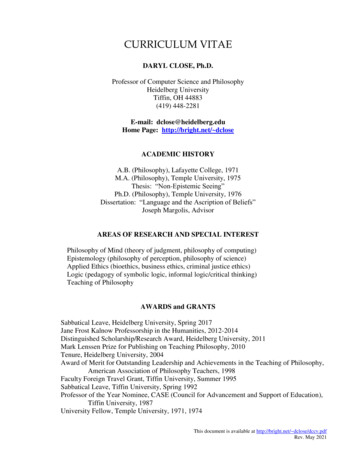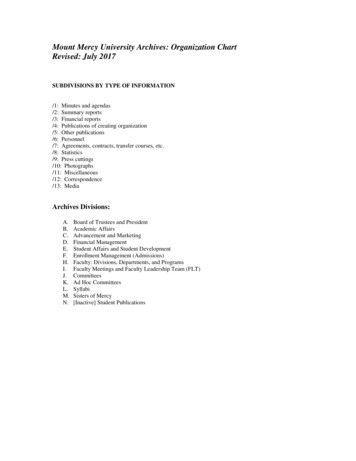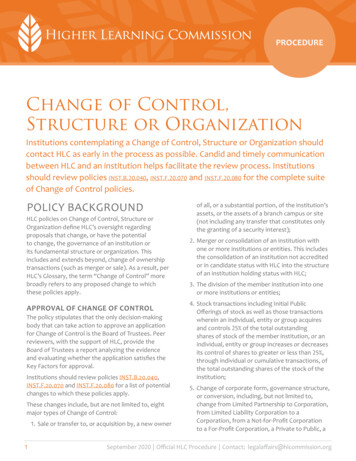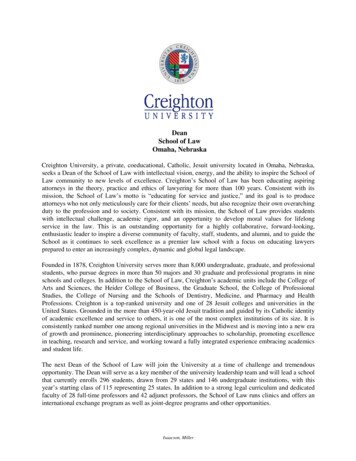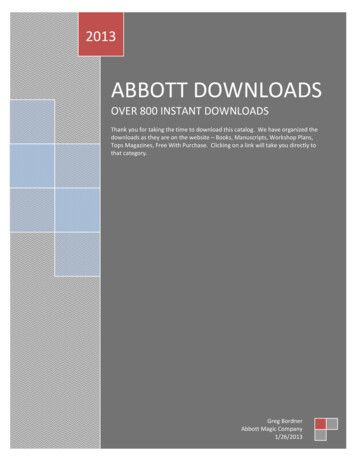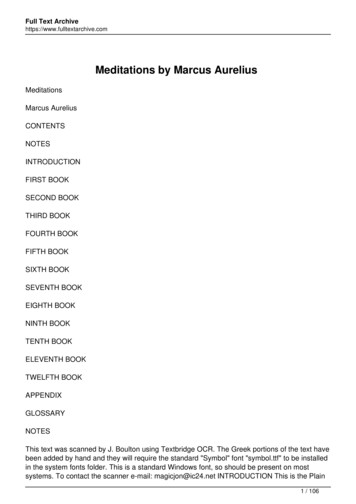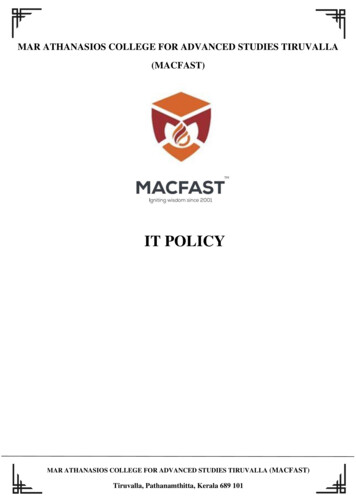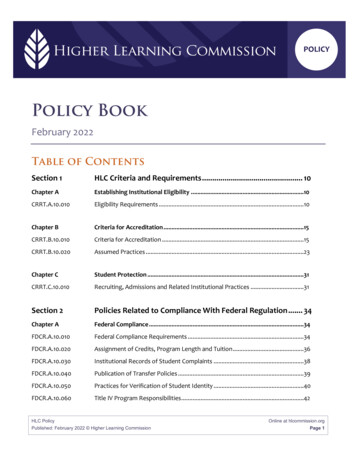
Transcription
Policy BookFebruary 2022Table of ContentsSection 1HLC Criteria and Requirements . 10Chapter AEstablishing Institutional Eligibility .10CRRT.A.10.010Eligibility Requirements .10Chapter BCriteria for Accreditation .15CRRT.B.10.010Criteria for Accreditation .15CRRT.B.10.020Assumed Practices .23Chapter CStudent Protection .31CRRT.C.10.010Recruiting, Admissions and Related Institutional Practices .31Section 2Policies Related to Compliance With Federal Regulation . 34Chapter AFederal Compliance .34FDCR.A.10.010Federal Compliance Requirements .34FDCR.A.10.020Assignment of Credits, Program Length and Tuition .36FDCR.A.10.030Institutional Records of Student Complaints .38FDCR.A.10.040Publication of Transfer Policies .39FDCR.A.10.050Practices for Verification of Student Identity .40FDCR.A.10.060Title IV Program Responsibilities .42HLC PolicyPublished: February 2022 Higher Learning CommissionOnline at hlcommission.orgPage 1
FDCR.A.10.070Public Information .44 Required Information for Students and the Public Information About Student Achievement Advertising and Recruiting Materials and Other Public Information Disclosure of Accreditation Status Public Notification of Opportunity to CommentFDCR.A.10.080Review of Student Outcome Data .46FDCR.A.10.090Standing With State and Other Accreditors .47FDCR.A.20.010Fraud and Abuse .49Chapter BTeach Out .50FDCR.B.10.010HLC Approval of Institutional Teach-Out Arrangements .50 Institutional Situations Requiring Submission of Provisional Plans forApproval HLC Requirements for Provisional Plans HLC Requirement for Teach-Out Agreement Approval of Teach-Out Receiving Institutions Accredited by HLC HLC Approvals Related to Teach-Out Institutional Closure Without Approved Teach-Out Planor Agreement; Failure to Comply With Teach-Out PolicySection 3Institutional Processes. 55INST.COVID.10.010Temporary Emergency Policy Related to COVID-19 .55Chapter AImplementation of HLC Criteria and Requirements .59INST.A.10.020Evaluative Framework for the HLC Criteria .59HLC PolicyPublished: February 2022 Higher Learning CommissionOnline at hlcommission.orgPage 2
Chapter BRequirements for Achieving and Maintaining Membership .61INST.B.10.010Jurisdiction .61INST.B.10.020 Incorporation Substantial PresenceComponents of Accredited or Candidate Institutions .63 Characteristics of a Component That May Be Includedin the Institution’s Accredited or Candidate Status Characteristics of a Separately Accreditable Component Processes for Including a Component Within the Accreditation Statusof the InstitutionINST.B.10.030Related Entities .66INST.B.20.010Eligibility Process.67 INST.B.20.020Eligibility ReviewersCandidacy and Initial Accreditation.69 Grant of Candidacy Evaluative Framework for Achieving and Maintaining Candidacy Grant of Initial Accreditation Early Initial Accreditation Evaluative Framework for Achieving Initial Accreditation Extension of Candidacy Evaluations Related to Granting Candidacy and Initial Accreditation Biennial Visit Withdrawal of Application for Candidacy Withdrawal of Application for Initial AccreditationINST.B.20.030Effective Date of Accreditation Actions .76INST.B.20.032Accelerated Process for Initial Accreditation .78 Qualifications to Apply for Initial Accreditation Throughthe Accelerated Process Application for Initial Accreditation Through the Accelerated ProcessHLC PolicyPublished: February 2022 Higher Learning CommissionOnline at hlcommission.orgPage 3
Comprehensive Evaluation for Initial Accreditation Throughthe Accelerated Process Decision Making for Initial Accreditation Through theAccelerated Process Evaluative Framework for Initial Accreditation Throughthe Accelerated ProcessINST.B.20.040Change of Control, Structure or Organization .81 Eligibility for Change of Control Types of Transactions Change of Control, Structure or Organization WithoutPrior HLC Approval Notification to HLC Regarding Other TransactionsINST.B.30.010Voluntary Resignation of Accreditation or Candidacy .85INST.B.30.020Obligations of Membership .87INST.B.30.030 Meeting Obligations of Membership Administrative Probation Disclosure of Administrative ProbationDues and Fees .91 Refunds Non-payment of Dues and Fees Debts to HLCChapter CProcess for Reaffirmation of Accreditation .93INST.C.10.005Pathways and Related Process Requirements .93 Pathways Overview Considerations in Determining Initial Pathway Assignmentsand Subsequent Changes Due Process Requirements Related to Pathway Assignments Standard Pathway Open PathwayHLC PolicyPublished: February 2022 Higher Learning CommissionOnline at hlcommission.orgPage 4
INST.C.10.010Substantive Requirements for Reaffirmation of Accreditation .97INST.C.10.030Process Requirements Leading to HLC Action Following Reviewsof the Criteria for Accreditation .99 Recommendations for HLC Action Based on Reviews of theCriteria for Accreditation INST.C.20.010Recommendations for HLC Action for Reaffirmation of AccreditationEvaluative Activities Applicable to All Institutions .101 Institutional Responses to RecommendationsChapter DDecision-Making Bodies and Processes .104INST.D.10.010Board of Trustees .104 Decision-Making Authority of the Board of Trustees Review and Analysis of the Full Record by the Board of Trustees Notice to Institutions of Board Actions Deferral of Action by the Board of Trustees Substantive Amendment or Modification to Board Actions Related toInstitutional Actions INST.D.20.010Process for Modifying or Amending Prior Board ActionInstitutional Actions Council.108 Composition, Selection, Term and Activity IAC Authority to Take Action on Accreditation Decision IAC Authority to Make Recommendations for Accreditation DecisionsThat Require Board ActionINST.D.40.010 Conflict of Interest Confidentiality Antitrust ComplianceInstitutional Actions Council Processes .112 Review and Analysis of the Full Record by the InstitutionalActions Council Institutional Actions Council ProcessesHLC PolicyPublished: February 2022 Higher Learning CommissionOnline at hlcommission.orgPage 5
Notice to Institution of Action or Recommendation by theInstitutional Actions Council Deferral of Action by the Institutional Actions CouncilChapter ESanctions, Adverse Actions, and Appeals .116INST.E.10.010Notice .116INST.E.20.010INST.E.30.010INST.E.60.010 Process for Imposing or Removing Notice Pathways Assignment Substantive Change During the Notice Period Public Disclosure of Notice Actions Notice Evaluation at the End of the Notice PeriodProbation .120 Process for Imposing or Removing Probation Pathways Assignment Substantive Change During the Probationary Period Public Disclosure of Probation Actions Comprehensive Evaluation Visit During ProbationShow-Cause (Procedural Order) .126 Process for Imposing or Removing a Show-Cause Order Board Committee Hearing in Show-Cause Pathways Assignment Substantive Change During the Show-Cause Period Public Disclosure During Show-Cause Show-Cause Evaluation Visit Institutional Responses to the Show-Cause Evaluation Visit ReportDenial or Withdrawal of Status .131 Withdrawal of Accreditation Public Disclosure After Withdrawal of Accreditation Denial of AccreditationHLC PolicyPublished: February 2022 Higher Learning CommissionOnline at hlcommission.orgPage 6
Denial or Withdrawal of Candidacy Status Public Disclosure After Denial of Accreditation or Denialor Withdrawal of Candidacy StatusINST.E.70.010Additional Board Procedures .136 Prior Notice to Member Institutions of Certain Intended Actions Board Committee Hearings Board Committee Hearing ProcessINST.E.80.010Reapplication Following a Denial or Withdrawal of Status .138INST.E.90.010Appeals .139 Grounds for Appeal Appeals Body and Appeal Panel Appeals Procedure Institutional Change During Appeal PeriodChapter FMaintenance and Monitoring .142INST.F.10.010Routine Monitoring and Data Collection .142INST.F.20.010INST.F.20.030 Data Reporting From Member Institutions Institutional Contact for Data Reporting HLC Follow-Up to Institutional Data Monitoring of Student Enrollment Growth Surveying of StudentsSpecial Monitoring .146 Presidential Recommendation Special Designations Process for Imposing or Removing a DesignationNon-substantive Changes in the Accreditation Relationship Betweenan Institution and HLC .150 Process for Initiating a Non-substantive Change in the RelationshipWith HLCHLC PolicyPublished: February 2022 Higher Learning CommissionOnline at hlcommission.orgPage 7
INST.F.20.040INST.F.20.050Substantive Change .152 Substantive Change Requiring Notification or Approval Approval of Substantive ChangeReview of Substantive Change.157 Substantive Change Review Process StructureINST.F.20.060Monitoring of Substantive Change .161INST.F.20.070Processes for Seeking Approval of Change of Control .163 Evaluative Framework for Change of Control, Structure or Organization Other Board Options Evaluations Related to Change of Control, Structure or OrganizationINST.F.20.080Monitoring Related to Change of Control, Structure or Organization .167Section 4HLC Obligations . 169Chapter AHLC Obligations to Institutions and the Public .169COMM.A.10.010Notice of Accreditation Actions, HLC Public Notices and Public Statements .169COMM.A.10.020Management of HLC Records and Information .172 Types of Institutional Records and Information Ownership of Institutional Records and Information Confidentiality of Institutional Records and Information HLC’s Communications With Institutions, and at the Request of Institutions,About Institutional Records and Information HLC’s Communication With Third Parties About Institutional Records andInformation Other Information About HLC’s Website Records RetentionCOMM.A.10.030Complaints and Other Information Regarding Member Institutions.177Chapter BHLC Staff .179COMM.B.10.010Staff Role and Responsibility.179 Institutional LiaisonHLC PolicyPublished: February 2022 Higher Learning CommissionOnline at hlcommission.orgPage 8
HLC Staff on Non-evaluative Visits HLC Staff on Evaluation Visits Staff Objectivity and Conflict of InterestCOMM.B.10.020Staff Authority.181COMM.B.10.030External Consultation .183Chapter CRelationships With External Agencies .184COMM.C.10.020Relations With Other Recognized Accrediting Agencies .184COMM.C.10.030Relations With the U.S. Government, State Higher Education Agenciesand Other State Offices .186Section 5Commitment to Peer Review . 188Chapter APolicies Applicable to All Peer Reviewers.188PEER.A.00.000Commitment to Peer Review .188PEER.A.10.010Eligibility Criteria and Selection .189PEER.A.10.020Terms of Appointment and Termination of Service .191 Terms of Appointment Termination of ServicePEER.A.10.030Required Training and Professional Development.193PEER.A.10.040Standards of Conduct .194 Independent ConsultingPEER.A.10.050Peer Corps Members on HLC Evaluation Activities .198Section 6Policies Related to Policy Adoption and Review . 200Chapter AGeneral .200PPAR.A.10.000Application and Regular Review of HLC Requirements andInstitutional Accreditation Policies .200PPAR.A.10.010Dating of Policies .202HLC PolicyPublished: February 2022 Higher Learning CommissionOnline at hlcommission.orgPage 9
Section 1: Criteria and RequirementsPolicy Title: Eligibility RequirementsNumber:CRRT.A.10.010An institution must meet all Eligibility Requirements before it is granted candidate status or accreditedstatus.Institutions participating in the Eligibility Process must present initial evidence that it meets theserequirements before a pre-application interview is scheduled with HLC. Through submission of the EligibilityFiling it must present full evidence that it meets these requirements before a site visit for candidacy isscheduled.Institutions participating in the Accelerated Process for Initial Accreditation must present full evidence that itmeets these requirements before a site visit for initial accreditation is scheduled.1. Jurisdiction of HLCThe institution falls within HLC’s jurisdiction as defined in HLC’s Bylaws (Article III). HLC extendsaccreditation and candidacy to higher education institutions that (1) are incorporated in or operating underfederal authority within, the United States; and (2) have substantial presence, as defined in HLC policy,within the United States.2. Legal StatusThe institution is appropriately authorized in each of the states, sovereign nations, or jurisdictions in which itoperates to award degrees, offer educational programs, or conduct activities as an institution of highereducation. At least one of these must be in HLC’s jurisdiction.3. Governing BoardThe institution has an independent governing board that possesses and exercises the necessary legal powerto establish and review the basic policies that govern the institution.HLC PolicyPublished: February 2022 Higher Learning CommissionOnline at hlcommission.orgPage 10
4. StabilityThe institution demonstrates a history of stable operations and consistent control during the two yearspreceding the submission of the Eligibility Filing or the application for initial accreditation through theaccelerated process.5. Mission StatementThe institution has a statement of mission approved by its governing board and appropriate for a degreegranting institution of higher education. The mission defines the nature and purpose of the higher learningprovided by the institution and the students for whom it is intended.6. Educational ProgramsThe institution has educational programs that are appropriate for an institution of higher education. HLCmay decline to evaluate an institution for status with HLC if the institution’s mission or educational programsfall outside areas in which HLC has demonstrated expertise or lacks appropriate standards for meaningfulreview.In appropriate proportion, the institution’s programs are degree-granting and involve coursework providedby the institution, establishing the institution’s commitment to degree-granting higher education.The institution has clearly articulated learning goals for its academic programs and has strategies forassessment in place.The institution:a. maintains a minimum requirement for general education for all of its undergraduate programswhether through a traditional practice of distributed curricula (15 semester credits for AAS degrees,24 for AS or AA degrees, and 30 for bachelor’s degrees) or through integrated, embedded,interdisciplinary, or other accepted models that demonstrate a minimum requirement equivalent tothe distributed model. Any exceptions are explained and justified.b. has a program of general education that is grounded in a philosophy or framework developed by theinstitution or adopted from an established framework. It imparts common knowledge andintellectual concepts to students and develops skills and attitudes that the institution believes everycollege-educated person should possess. The institution clearly and publicly articulates the purposes,content and intended learning outcomes of its general education program.c. conforms to commonly accepted minimum program length: 60 semester credits for associate’sdegrees, 120 semester credits for bachelor’s degrees, and 30 semester credits beyond the bachelor’sfor master’s degrees. Any exception to these minima must be explained and justified.HLC PolicyPublished: February 2022 Higher Learning CommissionOnline at hlcommission.orgPage 11
d. meets the federal requirements for credit ascription described in HLC’s Federal Compliance Program.7. Information to the PublicThe institution makes public its statements of mission, vision, and values; full descriptions of its programrequirements; its requirements for admission both to the institution and to particular programs or majors; itspolicies on acceptance of transfer credit, including how credit is applied to degree requirements; clear andaccurate information on all student costs, including tuition, fees, training and incidentals, and its policy onrefunds; its policies regarding good standing, probation, and dismissal; all residency requirements; andgrievance and complaint procedures.The institution portrays clearly and accurately to the public its accreditation status with institutional,specialized, and professional accreditation agencies as well as with the Higher Learning Commission,including a clear distinction between candidate or accredited status and an intention to seek status.8. Financial CapacityThe institution has the financial base to support its operations and sustain them in the future. Itdemonstrates a record of responsible fiscal management, including appropriate debt levels.The institution:a. has a prepared budget for the current year and the capacity to compare it with budgets and actualresults of previous years; andb. undergoes external financial audit by a certified public accountant or a public audit agency. Forprivate institutions the audit is annual; for public institutions it is at least every two years.(Institutions under federal control are exempted provided that they have other reliable informationto document the institution’s fiscal resources and management.)9. AdministrationThe institution has a Chief Executive Officer appointed by its governing board.The institution has governance and administrative structures that enable it to carry out its operations.10. Faculty and Other Academic PersonnelThe institution employs faculty and other academic personnel appropriately qualified and sufficient innumber to support its academic programs.HLC PolicyPublished: February 2022 Higher Learning CommissionOnline at hlcommission.orgPage 12
11. Learning ResourcesThe institution owns or has secured access to the learning resources and support services necessary tosupport the learning expected of its students (research laboratories, libraries, performance spaces, clinicalpractice sites, museum collections, etc.).12. Student Support ServicesThe institution makes available to its students support services appropriate for its mission, such as advising,academic records, financial aid, and placement.13. PlanningThe institution demonstrates that it engages in planning with regard to its current and future business andacademic operations.14. Policies and ProceduresThe institution has appropriate policies and procedures for its students, administrators, faculty, and staff.15. Current ActivityThe institution has students enrolled in its degree programs. (To be granted initial accreditation, aninstitution must have graduated students from at least one degree program.)16. Integrity of Business and Academic OperationsThe institution has no record of inappropriate, unethical, and untruthful dealings with its students, with thebusiness community, or with agencies of government. The institution complies with all legal requirements(in addition to authorization of academic programs) wherever it does business.17. Consistency of Description Among AgenciesThe institution describes itself consistently to all accrediting and governmental agencies with regard to itsmission, programs, governance, and finances.18. Accreditation RecordWithin the five years preceding the initiation of the process of seeking accreditation with HLC, the institutionhas not (a) been subject to a sanction or Show-Cause Order with another recognized accreditor; (b) has notbeen subject to an adverse action with another recognized accreditor; or (c) has not voluntarily resigned itsstatus with another recognized accreditor while subject to (a) or (b).HLC PolicyPublished: February 2022 Higher Learning CommissionOnline at hlcommission.orgPage 13
19. Good Faith and Planning to Achieve AccreditationThe board has authorized the institution to seek membership with HLC and indicated its intention, if amember of HLC, to accept the Obligations of Membership.The institution has a realistic plan for achieving accreditation with HLC within the period of time set by HLCpolicy.a. If the institution offers programs that require accreditation from a recognized accreditor in order forits students to be certified or sit for licensing examinations, it either has the appropriateaccreditation or discloses publicly and clearly the consequences of the lack thereof. The institutionalways makes clear to students the distinction between the various types of accreditation and therelationship between licensure and these various types of accreditation.b. If the institution is predominantly or solely a single-purpose institution in fields that require licensurefor practice, it demonstrates that it is also accredited by or is actively in the process of applying to arecognized accreditor for each field, if such a recognized accreditor exists.Policy Number KeySection CRRT: Criteria and RequirementsChapter A: Establishing Institutional EligibilityPart 10: GeneralLast Revised: February 2022First Adopted: February 2003Revision History: June 2006, June 2011, November 2020, June 2021, February 2022Notes: Former policy number 1.1(c), 2013 – 1.1(e). In February 2021, references to the Higher Learning Commissionas “the Commission” were replaced with the term “HLC.”Related Policies:HLC PolicyPublished: February 2022 Higher Learning CommissionOnline at hlcommission.orgPage 14
Policy Title: Criteria for AccreditationNumber:CRRT.B.10.010The Criteria for Accreditation are the standards of quality by which HLC determines whether an institutionmerits accreditation or reaffirmation of accreditation. They are as follows:Criterion 1. MissionThe institution’s mission is clear and articulated publicly; it guides the institution’s operations.Core Components1.A. The institution’s mission is articulated publicly and operationalized throughout the institution.1.The mission was developed through a process suited to the context of the institution.2. The mission and related statements are current and reference the institution’s emphasis on thevarious aspects of its mission, such as instruction, scholarship, research, application of research,creative works, clinical service, public service, economic development and religious or culturalpurpose.3. The mission and related statements identify the nature, scope and intended constituents of thehigher education offerings and services the institution provides.4. The institution’s academic offerings, student support services and enrollment profile areconsistent with its stated mission.5. The institution clearly articulates its mission through public information, such as statements ofpurpose, vision, values, goals, plans or institutional priorities.1.B. The institution’s mission demonstrates commitment to the public good.1.The institution’s actions and decisions demonstrate that its educational role is to serve thepublic, not solely the institution or any superordinate entity.HLC PolicyPublished: February 2022 Higher Learning CommissionOnline at hlcommission.orgPage 15
2. The institution’s educational responsibilities take primacy over other purposes, such asgenerating financial returns for investors, contributing to a related or parent organization, orsupporting external interests.3. The institution engages with its external constituencies and responds to their needs as itsmission and capacity allow.1.C. The institution provides opportunities for civic engagement in a diverse, multicultural society andglobally connected world, as appropriate within its mission and for the constituencies it serves.1.The institution encourages curricular or cocurricular activities that prepare students for informedcitizenship and workplace success.2. The institution’s processes and activities demonstrate inclusive and equitable treatment ofdiverse populations.3. The institution fosters a climate of respect among all students, faculty, staff and administratorsfrom a range of diverse backgrounds, ideas and perspectives.Criterion 2. Integrity: Ethical and Responsible ConductThe institution acts with integrity; its conduct is ethi
HLC Policy Online at hlcommission.org Published: February 2022 Higher Learning Commission Page 2 FDCR.A.10.070 Public Information .44
